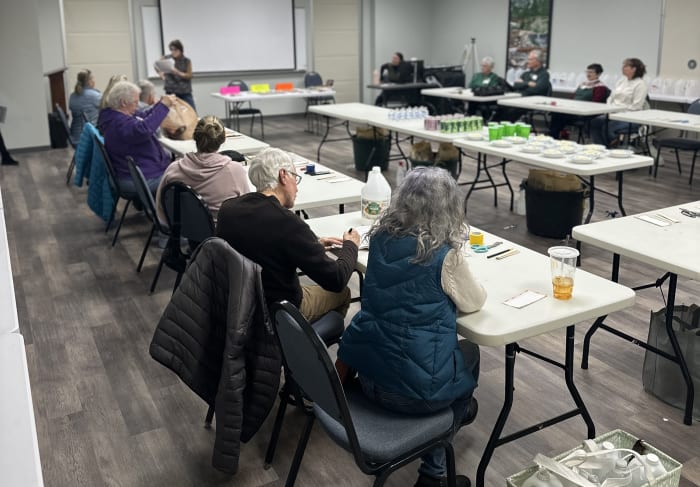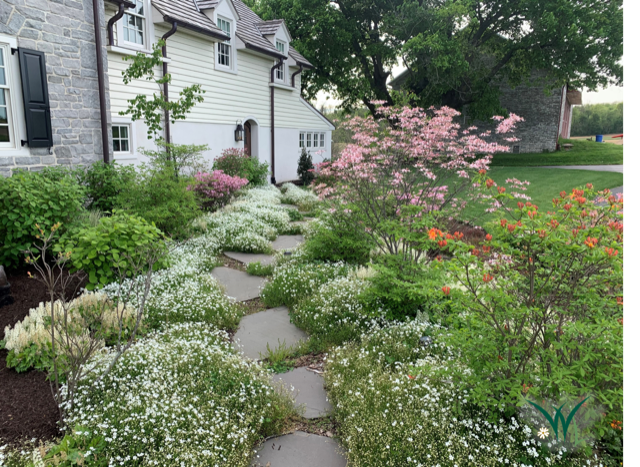Est. Read Time: 7 minutes
Winter sowing is one of the easiest—and most affordable—ways to start native plants.
We hear from a lot of people who want to plant native but feel held back by cost. Native plants can be pricey when you’re buying full-grown plants from a nursery, especially if you’re trying to transform more than a small corner of your yard.
That’s where winter sowing changes everything.
By using simple, recycled containers like milk jugs you can grow dozens of native seedlings outdoors with almost no equipment and very little money. No heat mats. No grow lights. No indoor setup. Just seeds, soil, and winter doing the work for you.
If cost has been a barrier, winter sowing gives you the freedom to start native plants at scale.
It can also be a fun and flexible project for families and communities. To help you bring others into the experience, we are sharing a Winter Sowing Party guide below, created by an HNP contributor, so you can host your own gathering and inspire more people to plant native.
Why It Works for Native Plants
Native plants evolved alongside the seasons where they live. They expect winter’s chill, spring’s thaw, and summer’s sun. By winter sowing, you’re working with those natural cycles.
It’s also one of the simplest ways to grow biodiversity at home. And like every native planting, your winter-sown seeds become part of the Homegrown National Park movement—restoring biodiversity, one jug at a time.
Why Winter Sowing Is So Affordable
- Uses free recycled containers (milk jugs, takeout boxes)
- No need for grow lights, heat mats, or indoor space
- Native seed packets often produce dozens of plants
- Costs a fraction of buying nursery plugs
- Nature handles cold stratification for you
Ways to Winter Sow
The milk jug mini-greenhouse method is one of the most popular approaches, but it’s far from the only one. Winter sowing simply means giving native seeds the cold, moist conditions they need before sprouting in spring. Here are several easy methods you can try:
1. Mini-Greenhouses (Milk Jugs or Clamshells)
This classic method uses recycled plastic containers, often milk jugs or clear salad “clamshell” boxes, to create small greenhouse-like conditions. They hold moisture, let in light and air, and protect seeds from animals.
Best for: beginners, small spaces, colder climates.

How to Make Your Own Milk Jug Mini-Greenhouse
- Poke 6 drainage holes in the bottom.
- Cut around the jug horizontally, leaving a hinge at the handle.
- Add 3–4 inches of moist potting soil.
- Label the plant on a wooden stake and place it inside.
- Sprinkle a pinch of seeds and press gently.
- Spray lightly with water.
- Tape the jug closed.
- Label the outside clearly.
After Your Milk Jugs are Made:
- Place jugs outside immediately (snow and rain help) in a sunny, protected location (a southeast-facing spot is perfect).
- Water only if the soil looks dry.
- Open jugs after the last frost.
- Transplant seedlings when they develop 2–3 real leaves—not counting the first small leaves (cotyledons).
2. Scatter Sowing (Direct to Soil)
Clear a patch of soil, scatter seeds in winter, and press them in lightly. Snow and rain do the watering for you.
Best for: meadow plantings, large areas, species that naturally drop seed.
3. Sowing in Planting Trays or Larger Containers
Instead of using individual jugs, you can sow native seeds in seed-starting trays, nursery pots, or other freeze-safe containers. Fill them with seed-starting mix, sow the seeds on the surface, and place the containers outdoors for the winter. Snow and rain keep everything naturally watered, and airflow helps prevent mold.
Trays give you neat rows of seedlings that are easy to monitor, while larger nursery pots work well if you want to grow many plants of a single species. Be sure to use freeze-resistant containers such as plastic or resin pots, especially in regions with harsh winters.
Best for: those who want organization, easy monitoring, and a lot of plants

Each method relies on the same idea: let winter do the work.
Try It as a Community Event: Winter Sowing Parties
Winter sowing is not only simple and inexpensive, it is also a great way to bring people together and introduce beginners to native planting. To show what this can look like in a real community, we are sharing a Winter Sowing Party contributed by one of our readers.

A Real Example: Liz’s Winter Sowing Party
Last winter, Liz Myers-Chamberlin hosted a Winter Sowing Party in North Carolina, and the event filled up quickly! Before the event even began, Liz shared:
“I’ve been dreaming of this day since I first realized the absolute ecological necessity of native plants, and then I discovered winter sowing as an easy, inexpensive, and effective way to propagate native seeds.”

Liz collected more than 125 recycled gallon jugs from two coffee shops, set up planting stations with soil and tools, grouped seeds by bloom time, and welcomed 20 attendees. After showing the 20-minute version of the What's the Rush video from Doug Tallamy, everyone planted several jugs of native seeds to take home.
The event sparked a wave of enthusiasm for native planting in her community, including staying in touch through a follow-up Facebook group.
Watch this 30-second compilation of Liz's Winter Sowing Party!
Host Your Own Winter Sowing Party
Winter sowing is a perfect entry point for beginners—and a low-stress, high-impact community event. Whether you’re part of a neighborhood group, garden club, school, congregation, or simply a community member looking to spread the word, it’s a fun way to connect people to nature and each other.
We’ve put together a simple guide you can download and share, including:
- supply lists
- setup instructions
- how to teach the process step-by-step
- and more
Have Event Ideas or Tips to Share? We’d Love to See Them
Event Feedback
Every winter sowing effort adds to the movement, and your experience can inspire others. If you host a Winter Sowing Party, we’d love to hear how it went. Sharing your attendance numbers, event details, photos, and any marketing materials helps us measure our collective impact and improve our guides for future hosts. Share your event details and photos here.
You can also tag us with your event images on social media! #HomegrownNationalPark #WinterSowingParty
Other Tips and Images
If you haven’t hosted an event but have suggestions, images, or tips for any winter sowing method, we would still love to hear from you. Please send your thoughts so we can continue strengthening these resources for everyone.
Every Seed Counts
Winter sowing is a simple act with powerful results. Each seed represents a step toward restoring the ecosystems that sustain us all.
When your seedlings are ready, transplant them once they have two or three true leaves (the real leaves that come after the tiny ones). Then add your plantings to the HNP Biodiversity Map to track your impact.
Together, we’re growing a living network of native habitat across the country.
Grow with Us: Native Flora Seeds
Ready to start winter sowing? You can make an even bigger impact by ordering your seeds from Native Flora Seeds.
Native Flora donates 100% of proceeds directly to our nonprofit mission. Their seeds are regionally appropriate and perfect for winter sowing native plants.
If you enjoy seeing how others are growing this movement, be sure to read our Volunteer Spotlight on Jim Carras, the founder of Native Flora Seeds. His story shows how one person can spark real change in their community: Read From Garage to Grassroots
A Special Thank You

A heartfelt thank you to Liz Myers-Chamberlin for sharing her Winter Sowing Party, materials, and enthusiasm with the Homegrown National Park community.





